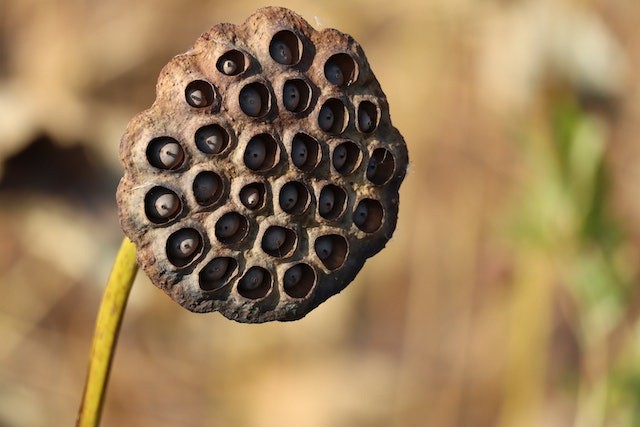
A lotus seed pod may not appeal visually to those with trypophobia or fear of holes. However, some use them for floral arrangements.
What Is a Lotus Seed Pod
The lotus seed pod is the fruit of a lotus flower. Lotus grows in water and produces large, beautiful flowers.
The flowers of the lotus tree are exquisite and have a distinctive appearance. The answer to the question "Do they produce seeds?" is that they do!
Its fruit has a large, round, greenish-brown seed pod filled with small, hard, black seeds. In the heart of the bloom is a pod that houses the seeds. The pod will crack open and release the seeds when fully mature.
Some lotus plants don't produce seed pods. Some species are sterile and incapable of producing seeds. However, if they are pollinated, many lotus plants will yield seed pods.
About 20 seeds grow in each lotus pod for 40 days. Inside the lotus seed head are rows of cylindrical to spherical, oval-shaped, dark green seeds.
In huge ponds or lakes, lotus pods develop. The lotus plant is a water lily with long stems and broad, spherical, green leaves. The lotus plant produces white or pink flowers that float on the water's surface. Round, green fruits that hold the plant's seeds appear after the flowers.
Nelumbo, sometimes known as the lotus, is an aquatic plant with fragrant leaves and attractive flowers. Usually, lotus plants need good maintenance. You should put them in a sunny area and fertilize them sparingly. You can keep them at home in a cool location if freezing is a problem.
Benefits and Uses of Lotus Seed Pods
Lotus pods are the most common and well-liked pods in the flower industry. The seeds are spherical and rounded, and each pod is entirely and organically dried. Various lotus pods on stems can be used in flower arrangements to accommodate different lengths.
Their striking, sculptural appearance makes them the ideal component for dried floral arrangements. Their deep brown tones and unique shape will give a bit of boldness to any dried flower arrangement. They pair particularly well with lush green gum leaves or Emu Feather Fern.
For some time, florists, event coordinators, and interior designers have favored dried flowers and grasses, and it doesn't appear that this trend will soon fade. The lotus pod is all earthiness and boldness, in contrast to many of our dried blooms, which may bring a touch of whimsy and delicacy to a bouquet or arrangement.
Whether you select the smaller or larger pods, they will serve as the centerpiece of your flower arrangement. Most of the other natural shapes and hues of our dried grasses and flowers can offer height and a sculptural element that works well together.
Lotus seed pods are also great ingredients for a sensory box. Children and adults who struggle with sensory difficulties might benefit greatly from sensory toolboxes.
The boxes offer a way to learn and a technique to cope with overwhelming settings, loud noises, bright lights, and other factors. You decide what goes in a sensory box as long as it contains intriguing sensory items that appeal to the five senses - touch, taste, smell, auditory (hearing), and sight (visual). The lotus pods are a wonderful addition to a sensory box with a natural theme, along with things like sand, soft cotton buds, cinnamon sticks, and pine cones.
RELATED ARTICLE : Homeowner Shot a 7-Foot Alligator 4 Times in the Head While the Beast Was Biting His Dog; FWC Will Not File Charges for the Killing
Check out more news and information on the ENVIRONMENT & CLIMATE in Science Times.
© 2025 ScienceTimes.com All rights reserved. Do not reproduce without permission. The window to the world of Science Times.











